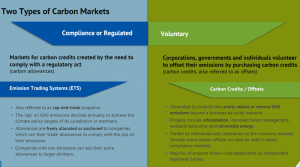Are Trade Carbon Credits Still Working?
Trade Carbon Credits Still Working
For the first time in years, carbon credit markets are thriving, thanks to a wave of corporate net-zero goals and interest in meeting the global climate targets laid out in the Paris Agreement. Traders in the voluntary market—where companies buy credits to offset their emissions rather than reduce them on their own—have matched a growing pool of buyers with suppliers. That’s great news for farmers, ranchers, and landowners who have captured or reduced carbon dioxide (CO2) through farming or forestry practices, as well as middlemen that facilitate the sales of these credits to end buyers.
But the voluntary market’s success has also raised questions about whether it can scale to meet the needs of an increasingly large number of buyers and sellers. A new report by McKinsy, the Institute for International Finance, and the Taskforce on Scaling Voluntary Carbon Markets, estimates that demand for trade carbon credits could multiply by a factor of 15 or more by 2030. That’s why the report, which was funded by IIF with knowledge support from TSVCM, focuses on how to grow this “downstream” market.

To date, a handful of countries have mandated that their companies purchase credits to compensate for their own emissions. These are called the compliance markets, and they’re currently dominated by Europe’s Emissions Trading Scheme, California’s cap-and-trade system, and the nine states on the east coast that formed the Regional Greenhouse Gas Initiative.
Are Trade Carbon Credits Still Working?
Under these schemes, governments set a limit on how many emissions certain sectors can release, and then allow the market to determine prices for those limits, which may rise over time to account for inflation and other factors. Companies that emit more than their allotted amount have to buy additional carbon credits on the compliance market from smaller emitters in order to remain below the limits.
The underlying projects that create these carbon credits can vary in size and scope, from small-scale reforestation to massive coal-to-natural gas power conversion plants. In the current market, a credit can be bought for as low as a few cents per metric ton of CO2 equivalent for small-scale reforestation and as high as $100 or more for carbon capture technologies like CCS.
To make the marketplace efficient, there’s a need for a common taxonomy that can describe these different attributes and help match buyers with the right suppliers. The report authors suggest that standardized features based on core carbon principles would be the best start.
Until the marketplace is able to better match demand and supply, the authors warn that the current voluntary market could begin to lose its value. They recommend that the IIF, standard-setting organizations, financial institutions, and market-infrastructure providers address these challenges to develop a robust market that will serve future demands. But for now, the world’s largest companies are buying up carbon credits in large numbers to meet their net-zero goals and demonstrate that they’re doing their part to slow down global warming. And it looks like they’ll be doing so for some time to come.